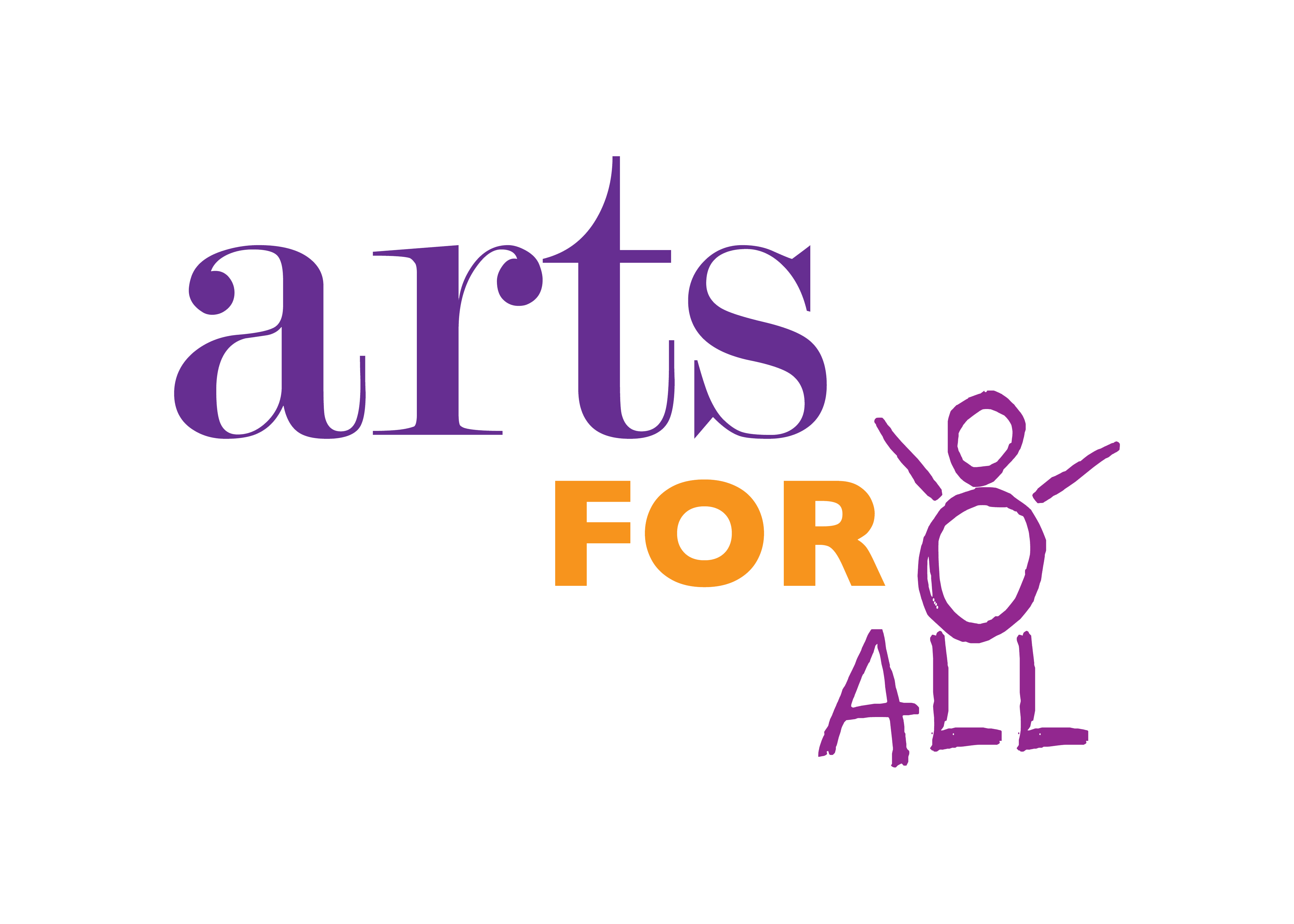“A Day in the Classroom with Arts For All” highlights the work of our teaching artists with the students in our programs. During the Spring of 2023, Arts For All intern Melody Fay Browning (NYU ’23) had the opportunity to shadow seven teaching artists at their respective schools. Observing each teaching artist over several weeks, Melody was able to provide an in-depth look into the classroom and the progress of the students in AFA’s programs as well as interview the teaching artists about their specific classes. This week’s post will showcase the work of Teaching Artist Stephanie Martinez.
Written by AFA Spring 2023 Intern Melody Fay Browning
January 24th, 2023
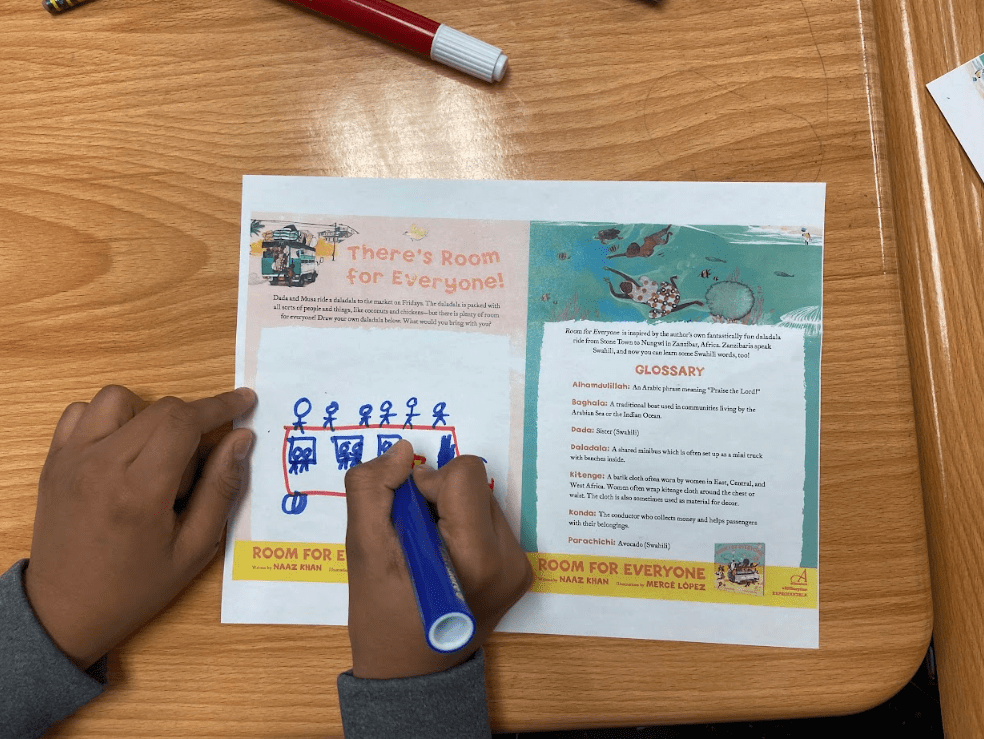
Photo By Melody Fay Browning
On Tuesday, January 24th, I had the pleasure of joining teaching artist Stephanie Martinez in two classrooms for a Literacy through the Arts class as well as an Artist Residency Program. At PS 163, Stephanie asked the third-grade class to welcome me to the room, which the children all did enthusiastically. Stephanie then encouraged the class to share stories of times when they felt welcome or that they welcomed someone else. The children were excited to talk about their friends and families and happy memories when others made them feel at home or they could share the same kindness to someone else. After a few minutes of happy sharing time, the children gathered in the corner of the classroom to hear Stephanie read aloud from the book “Room for Everyone.” Stephanie explained that the book is based in Zanzibar so there might be some words that the children don’t recognize, such as “daladala,” which is the bus that the main character Musa rides on as he discovers that there’s room for everyone. Stephanie explained the meaning of various words from the book to the children, and encouraged them to point those words out when they heard them in the story. After the children learned about all the people and things that ended up on Musa’s daladala, it was time for them to decide what would be on theirs. I helped Stephanie pass out coloring sheets with daladalas for the children to fill with anything and everything that is important to them. It was so fun to see the children excitedly discussing all the things and people that they love and why it was important that they add it to their daladala. One of the students seemed to only be drawing people, so I asked him to share with me what was in his daladala. He pointed out to me how each person was a member of his family: parents, siblings, cousins. He said that his family is the most important thing and that “they got each other for life,” so it only made sense to make sure his whole family fit in the daladala first. There were a few minutes at the end of the class for the children to share their drawing with each other and talk about the things they chose to add. It was so heartwarming to hear them talk about the things that are important to them and how much the people in their lives have impacted them at such a young age.
Stephanie and I then went on to our next stop which was a theatre-based class with fourth and fifth graders at PS 310. The children were very energetic and excited for Stephanie to be there, and intrigued by my presence, but none the less welcoming to the stranger in the room. Stephanie started out the class with a warmup called “Everything Ball.” A game where we toss around an imaginary ball that changes every time it’s passed from person to person. The children would be tossed the ball, then have to act out and explain to us how the ball had changed. Maybe now it was so heavy, but also soft and squishy, and smelled like strawberries. After a quick snack break, Stephanie moved on to the main activity of the day, a long-form improv exercise based on the TV show “Shark Tank.” The children were split into pairs and given a random object to work with. The rules were that they had to present to us, the audience, a pitch on their object and its use and make us want to invest in it, but they had to make up a new use of the object they were given. After a few minutes to prep with their partners, the duos got on stage and gave us their pitches. Some filled with cartwheels, funny voices, and lots of showmanship. One pairing, given a slide-whistle, explained to us that their object was an inter-dimensional portal opener- but be careful! Alien monsters might come through and it costs an extra couple million dollars to add on a special devise that keeps them away. It was so much fun to see the class turn ordinary objects into such creative ideas and be given the space to be silly and expressive. All the students put their all into the exercise and it really showed in the joy they expressed when they got up onstage. It was such a fun first day out in classrooms with Arts for All, and I can’t wait to see more of the way these programs are positively impacting students like the ones I spent time with today!
February 14th, 2023
On Tuesday, February 14th I had the joy of joining teaching artist Stephanie Martinez for two different classes. At PS 163, Stephanie started the class by asking the children to show her thumbs up or down depending on how they were feeling that day. After that quick check in, Stephanie read the book “Somebody Loves You Mr Hatch,” about a man who feels like he has no one who loves him until his neighbors and community come together to show him he’s loved. The children talked through what they noticed about Mr. Hatch through context clues in the book, then discussed how important it is to show love to people in our lives, especially those who we can tell need a little extra love. The children then made their own Valentine’s Day cards for someone in their lives who need extra love. The colored the cards and wrote notes to the person they thought of. Many of the children chose their parents or a family member, but some chose a certain friend and one child decided that he needed extra love that day and wrote a card to himself. It was so heartwarming to see how the children knew exactly who to make a card for and exactly what they wanted to say to show love to that person.
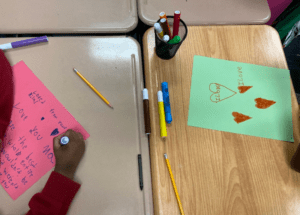
Photo By Melody Fay Browning
We then traveled to PS 310 for a theatre-based class and the children were all excited and ready to get started with Stephanie. The class started by circling up and talking about the way they show love on Valentine’s Day. Many of the children said they were a good friend today or that they passed out special treats to their classes. Stephanie then started the class activity by demonstrating walking into an invisible wall and entering a door. She then asked the class if they knew what this was called, and the group eventually found the answer of pantomime. Stephanie explained the meaning of pantomime, acting through gestures, movement, and emotions, without words or props. Stephanie then let the class try out pantomiming a few activities like picking a flowing and blowing up and tying a balloon. The class had a great time trying this and seemed to pick it up very fast. For the rest of the class, Stephanie split the class into groups and gave them a task and challenged them to include that task in a pantomimed scene. The children all did a great job and were very committed to trying their best and entertaining the rest of the children. It was a really great class to spend time with since the group had such fun and engaged energy.
Teaching Artist Stephanie Martinez Interview Part 1:
Q: What factors do you think about when developing your lesson plans?
Stephanie: When developing lesson plans I have to think of a few things: Firstly, the age level of the students I’m working with. This is especially important when I’m picking out books to center a lesson around, seeing as they should be age and reading level appropriate. Secondly, their previous theater experience/experience with me. Kids who already have theatrical experience will have an entirely different lesson with me than those who haven’t. And thirdly, what is our learning goal? What do I want the students to get out of the lesson? Maybe it’s a new skill or experience, maybe it’s to raise their confidence, or maybe it’s just to have fun for fun’s sake.
Q: How do you navigate classrooms with children that are at different levels of learning and skill?
Stephanie: Lots and lots of patience and adapting on the spot. There is a student in one of my classes who is fairly new to the school and only speaks French, which is unfortunately not a language that I (or his classmates and teacher) speak. However, through lots of help from his peers and several weeks in class with him, he’s starting to participate a lot more and really get into the swing of class. Some kids are farther along than others in various areas and that’s ok, but I try to make each one feel special and that they bring something unique to the class, regardless of skill level.
Q: What do you hope children in your classes take away from your lessons?
Stephanie: I want kids to take away several things from my lessons. First and foremostly joy, which is one of the pillars of my practice. In my opinion, if a lesson isn’t fun and enjoyable somehow, there’s little point. But I also hope that they take away a willingness to try new things and expand their horizons, whether that be in the books they read or the people they talk to, or just the act of being unabashedly silly.
March 7th, 2023
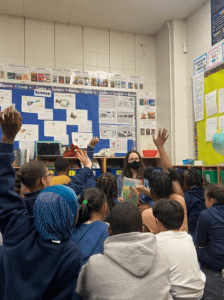
Photo By Melody Fay Browning
On Tuesday, March 7th I had the joy of joining teaching artist Stephanie Martinez for two classes at PS 163 and PS 310. At PS 163 the class started out by telling me about how the previous class they had painted rocks to create art pieces and were challenged by Stephanie to leave them around their community as an act of kindness. Many of the children left them by trees and in parks. We then talked about moments in the children’s lives where they went out of their way to show kindness to someone else or someone else showed them kindness. After the sharing, Stephanie led a game of “The Big Wind Blows,” which is a game where the children stand in a circle and switch spots with someone across from them when a prompt they relate to is called out. Stephanie based the questions around who likes which fruits and vegetables because this related to the theme of the book the children would read next. The class had a lot of fun with this game and we’re shocked and surprised at some of their classmates answers. Next Stephanie read a book called “The First Strawberries,” which is based on a Cherokee legend about the discovery of strawberries. Stephanie then led the children in an activity she called a “Berry Walk,” where the class practiced moving around the room at different levels of intensity while we pantomimed picking fruits on the way.
Next, Stephanie and I went over to PS 310 where we were enthusiastically greeted by the class and joined by teaching artist Gabby Baba-Conn. As a quick ice breaker, we all sat in a circle and Stephanie asked the class what celebrity we would want to hangout with if we had the chance. Many of the children mentioned musical artists that they admire. Then Gabby led the class in a physical warm up to get ready for the main activity of the class, which was learning original choreography to “You Can’t Stop the Beat” from the musical “Hairspray.” The class had a lot of fun learning Gabby’s choreography, and she invited the class to improv and contribute their ideas during certain sections of the dance. They whole group was really excited about the chance to add their own twist and ideas to the choreography and left ready to learn the rest next week!
March 21st, 2023:
On Tuesday, March 21st I had the joy of joining teaching artist Stephanie Martinez for two different classes at PS 163 and PS 310. At PS 163, Stephanie led a lesson about poetry. She read sections from Shel Silverstein’s “Where the Sidewalk Ends,” and the children discussed what they noticed about the poem, such as whether it rhymed. The class had a lot of fun reacting to the poems and some of the outrageous and silly settings that Shel Silverstein created. Stephanie then led the class in creating their own poem. She explained the A-B-A-B structure to create a poem where every other line rhymes. The class ended up with a poem titled “The Dog with the Long Tail” and had a lot of fun coming up with it, but were also challenged not only to be creative but also to use their language and rhyming skills.
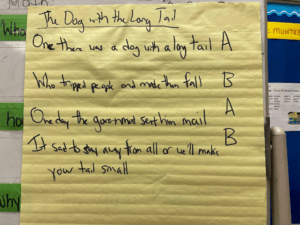
Photo By Melody Fay Browning
Then, Stephanie and I traveled over to PS 310 for a theatre-based class. In today’s class, Stephanie was focused on commedia del’arte, and taught a lesson about the character “types” you find in this form of theatre also known as stock characters. As a warmup, Stephanie gave the class monologues based on the character type of “the lovers” and asked the class to take turns performing them in as exaggerated and dramatic fashion as they could. Stephanie then began teaching the class about some of the different “types,” showing the class images of what the types would physically look like and how they would be costumed. The class then practiced each type’s physical movement focusing on the character’s “center,” or where their body leads from what they walk and move. The class had a lot of fun with being able to be silly a big with their physical movements and improv lines for the characters they became.
March 28th, 2023
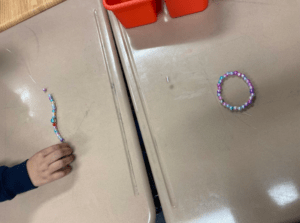
Photo By Melody Fay Browning
On Tuesday, March 28th I had the pleasure of joining teaching artist Stephanie Martinez for two classes at PS163 and PS 310. At PS 163, Stephanie read the book “Julián is Mermaid,” and the class discussed how Julián loved to dress up as a mermaid and maybe that made him feel different from others, and how hard it is to be yourself when you feel like others are going to judge you. The class then made their own mermaid inspired bracelets inspired by Julián. The class had a lot of fun choosing breads for their bracelets and many of the children told me they were going to give the bracelet to someone special to them like their moms or sisters.
Stephanie and I then went over to PS 310, where the class continued to learn about commedia del’arte and the stock characters found in this form of theatre. Stephanie demonstrated how more of these characters walk and move and the whole class tried out the characters. Next, Stephanie explained to the group that next week they would be creating group scenes with original characters inspired by the stock characters they’ve learned. The class split into group to start working on their scenes and create a plan for their characters. After they had a little time to work in groups, Stephanie brought out masks for the class to use for their performances. Before the class ended, they had a few minutes to start working on their masks, making sure that they fit the character they were going to play and the scenes they were creating. I was really excited to see that the class would be creating their own scenes together because developing their skills of collaboration is so important and giving them the creative freedom to create scenes is really great for this class that is so ready and excited play and express themselves through theatre.
Teaching Artist Stephanie Martinez Interview Part 2:
Q: At PS 163, you’re working with 3rd graders for a literacy through the arts program. What have been some ways you’ve been able to keep them engaged or excited about the art you’re bringing into the classroom?
Stephanie: I try to do new arts things all the time and they very much need to connect to the book today. So, in one book we read they made a necklace, so we made a necklace. There are other times where we’re reading a book and we’re doing scenes from the book. There have been other times where we’ll write a letter, or we’ll do poetry. So I try to keep the actual art form fresh every time and always relevant somehow to the book, while also like being age appropriate, so that way if they’re the kids say “I’m not good at this one thing,” it’s fine because we probably won’t be doing the same thing next week, and that’s okay. And if you are excited about something, they will be excited about it.
Q: At PS 310 you’re doing an artistic residency program with 4th and 5th graders. How do you determine which theatre skills are going to be beneficial to bring into the class?
Stephanie: There are certain skills that are very basic and important that everyone should know. Like improv for example is something everyone should try. To be a theater person, even if you’re not especially good at it, you should try it. Everyone should try some choreography. Again, even if they’re not good at it, it’s very basic things that might be helpful down the line. So again, it’s also a lot of what is age appropriate? What is new? What is fresh that they can try? And when they’re at this age they’re such blank canvases, just always trying new things, and if something doesn’t work, maybe next time I’ll switch it up. Or something really works, but this needs more than one day. Then I’ll split it up into two lessons, so lots of trial and error.
Q: I’ve noticed that play and silliness are a big part of the work you’re doing at PS 310. Why do you think that’s important and how do you nurture that playful environment?
Stephanie: I think the idea of play, especially for kids who are super young, and this is their first time doing theatre, is really important. I think kids should not be putting on a show at this age because they don’t quite know the rules yet and they need to play first. They need to like figure out what is acting? What is a character? Not even, what is a stage? Forget what is a stage. Just how does it feel to play pretend? But I think also getting them out of their comfort zone, because again, they’re not usually doing many of the things that I talk about or that I have in my practice. Especially at that age where they’re almost in middle school, they’re about to enter a time where they’re hyper conscious of themselves and how everyone perceives them. So to get them in that sweet spot where they can be silly and not care what they look like because being silly is more fun than caring what we look like. Even as adults you forget how to play. Because we’re so focused on the end product. We just need to enjoy the actual art of play.
April 18th, 2023
On Tuesday, April 18th I had the joy of joining teaching artist Stephanie Martinez for two different classes at PS 163 and PS 310. At PS 163, Stephanie focused her lesson for the day around puppetry. The class discussed what puppetry was and how many kinds of puppetry there are. Stephanie addressed how almost anything can be used as a puppet, using a folder to demonstrate how you can open it and close it to make it talk. She also talked about how there are more than just hand puppets, such as puppets with strings or puppets that use your whole body to operate. The class then split into groups at their tables to come up with an idea for a scene using puppets based in NYC. Then each student was given a paper bag to decorate to create their own hand-puppets. The children all had a lot of fun with this, creating faces for the puppets and giving them voices.
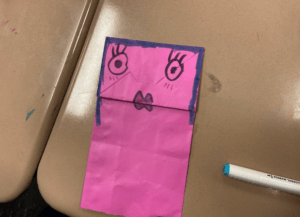
Photo By Melody Fay Browning
Stephanie and I then traveled over to PS 310 where the theatre-based class was also focusing on puppetry. The class there read a book called “Punch in New York,” which brings in the themes of puppetry and New York City that Stephanie was introducing. Stephanie then went over some basics of puppetry and talked to the students about creating their own scenes. The class was given time with their assigned groups to plan and structure a scene that had a beginning, middle, and end. Then they were given their paper bags and craft supplies to get started on creating puppets that fit their characters in the scenes they planned. Both classes today were very enthusiastic about the ideas of working with puppets and it was great to see how engaged they were with creating original scenes.
